
Understanding Moisture-Resistant Plasterboard
Explore the benefits, installation, and use cases of moisture-resistant plasterboard in construction and refurbishment projects.
Introduction
Moisture-resistant plasterboard is designed to perform better than standard plasterboard in areas prone to humidity and wet conditions. This article aims to delve into its properties, benefits, and installation insights.
Benefits
Moisture-resistant plasterboard, often referred to as 'green board', offers enhanced water resistance, making it ideal for use in bathrooms, kitchens, and other damp environments. It helps to prevent mould growth, and its durability ensures long-lasting performance.
Properties
The core of moisture-resistant plasterboard contains additives that reduce water absorption compared to standard plasterboard. The outer layers are typically treated to repel water, enhancing protection and reliability.
Installation
Installing moisture-resistant plasterboard is similar to standard plasterboard but requires careful handling to ensure moisture sealing. It's crucial to use appropriate jointing compounds and moisture-resistant fittings. Sealing edges and joins with the correct materials is essential to maintain the board's integrity.
Use Cases
This type of plasterboard is best suited for:
- Bathrooms: Around showers, bathtubs, and sinks where water exposure is high.
- Kitchens: Areas where steam and spills are common, behind countertops and appliances.
- Utility rooms: Spaces with washing machines or basins that could experience excess moisture.
Conclusion
Moisture-resistant plasterboard is a critical material for ensuring the longevity and health of your damp-prone areas. Proper installation and maintenance can help maximise its benefits.
For more detailed guidance and resources, visit the Plastering FX Academy website.